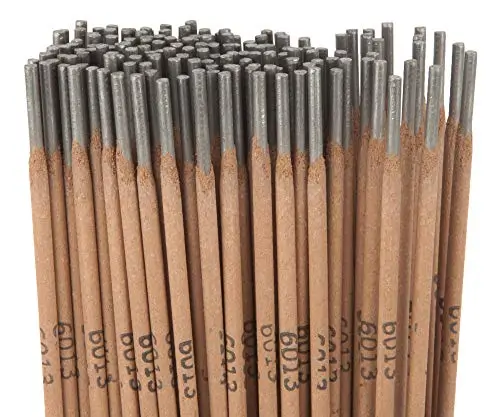E6011 and E6013 electrodes share similar tensile strength and welding positions, but E6011 excels in heavy-duty, deep penetration welds on unclean materials, while E6013 offers a stable arc for precise, clean welds on sheet metal, making it more beginner-friendly.
When you’re using an arc welding machine, choosing your electrode is an important business. You have to decide between consumable and non-consumable electrodes. Then, you still have to decide between many similar electrodes that have numbered names that beginners find incomprehensible. For example, how do you tell the 6011 and 6013 welding rods apart?
Here is everything you need to know to decide which of these rods is better for your welding application.

Table of Contents
What Is a 6011 Welding Rod Used For?
Before getting into the different properties of these two welding rods, it’s helpful to think about their practical applications first. Especially if you’re a beginner, thinking practically makes understanding the differences between different welding rods easier.
The 6011 welding rod is an iron welding rod used in situations that require sturdy joints. It provides deep penetration and a very secure weld.
Another important property of the 6011 welding rod is its resistance to contamination. Even if your surface has rust, paint, or thick layers of dirt, you can use a 6011 electrode to weld together two metals.
Basically, this electrode is perfect for industries where the work gets a little messy and you don’t have time to clean, such as:
- Farming
- Automotive repairs
- Factory floor machine repairs
When Can’t You Use a 6011 Welding Rod?
However, there are some situations where the sturdiness of a 6011 welding rod works to its disadvantage. They often burn through sheet metal and other thinner materials instead of actually welding. Plus, the thick bead is hard to control if you are not comfortable with a welding machine in your hand.
6011 welding rods are functional, but they’re not very nice to look at. That’s why people use them to repair farming equipment and not make beautiful iron decorations. However, if you care about the appearance of your weld, for example if you are repairing furniture or preparing items for sale, it won’t be easy to get a weld that looks nice using a 6011 welding rod.
What Is a 6013 Welding Rod Used For?
Now that you know all the ins and outs of using a 6011 welding rod, let’s look at when you should use a 6013 welding rod. The applications are slightly different because 6013 welding rods are more delicate. You use them more with thin pieces or sheet metal, while you use 6011 welding rods with thicker, sturdier pieces of metal.
Just because you use 6013 welding rods with thinner pieces of metal, that doesn’t mean the applications are all delicate. There are many heavy industrial situations when you need to weld together thinner pieces of metal and a 6013 rod becomes useful. This tool is often used in:
- Manufacturing vehicle bodies
- Making furniture
- Building storage tanks
Besides these highly functional applications for welding, 6013 welding rods are also good for aesthetics. The delicate weld means the joint will have clean lines that blend in with the rest of the job. As mentioned above, that is why the 6013 is often used for making furniture. You can also use a 6013 welding rod to make welding art and express yourself creatively.
If you are making and selling welding projects to make money, you want them to be functional and beautiful so people will want to buy them. That is when a 6013 welding electrode comes in handy.
When Can’t You Use a 6013 Welding Rod?
However, the 6013 welding rod is not sturdy enough to handle more demanding structural welds. In the United States, using a 6013 electrode on a root pass weld is a big no-no because people don’t believe in the strength of this electrode. 6013 electrodes are also not the best choice for welding at a relaxed angle as that leads to more slag formation (the 6013 rod’s dirty little secret is that it causes a lot of slag).
Different Properties of the 6011 and 6013 Rods
Now that you know the different uses of these two rods, let’s examine the properties that make them different, including:
- Polarity
- Tensile strength
- Penetration
Polarity Differences
The 6011 and 6013 rods actually have the same polarity. They both work with alternating and direct currents. Although alternating currents are far more common in welding, it’s still useful to know that you can use both of these electrodes in situations where you need to use a direct current. For example, direct current is better for materials that need a higher temperature to melt.
Tensile Strength Differences
6011 and 6013 welding electrodes have the same tensile strength, about 60,000 psi. The first two numbers of an electrode name indicate the tensile strength, and since both start with a “60,” that means their maximum tensile strength is the same.
Penetration Differences
The biggest difference between the 6011 and 6013 is the penetration. 6011 electrodes have a medium to full penetration, while 6013 electrodes have a light to medium penetration. Penetration refers to how far below the surface the weld can go. Since 6013 electrodes have a light penetration, that makes them better for welding thin materials without burning them. On the other hand, sturdier 6011 electrodes with their thicker penetration can work with thicker materials.
Final Thoughts
6011 and 6013 electrodes are very similar. They are made of the same material, iron, have the same tensile strength of 60,000 psi, and have the same polarity. However, they differ in terms of penetration because the 6011 is much sturdier than the 6013. That means the applications are also slightly different since you can use 6011 electrodes for sturdy tough jobs in the field and the 6013 for delicate repairs.


